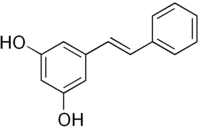Pinosylvin
 | |
| Names | |
|---|---|
| IUPAC name
5-[(E)-2-Phenylethenyl]benzene-1,3-diol | |
| Other names
(E)-3,5-Stilbenediol trans-3,5-Dihydroxystilbene | |
| Identifiers | |
| 22139-77-1 (E isomer) 102-61-4 (Mixture of E & Z) | |
| 3D model (Jmol) | Interactive image |
| ChEMBL | ChEMBL101506 |
| ChemSpider | 4444110 |
| ECHA InfoCard | 100.208.695 |
| PubChem | 5280457 |
| |
| |
| Properties | |
| C14H12O2 | |
| Molar mass | 212.244 g/mol |
| Melting point | 153 to 155 °C (307 to 311 °F; 426 to 428 K) |
| Except where otherwise noted, data are given for materials in their standard state (at 25 °C [77 °F], 100 kPa). | |
| | |
| Infobox references | |
Pinosylvin is a pre-infectious stilbenoid toxin (i.e. synthesized prior to infection), contrary to phytoalexins which are synthesized during infection. It is present in the heartwood of Pinaceae.[1] It is a fungitoxin protecting the wood from fungal infection.[2] It is also found in Gnetum cleistostachyum.[3]
Injected in rats, pinosylvin shows a rapid glucuronidation and a poor bioavailability.[4]
Biosynthesis
Pinosylvin synthase is an enzyme that catalyzes the chemical reaction 3 malonyl-CoA + cinnamoyl-CoA → 4 CoA + pinosylvin + 4 CO2
This biosynthesis is noteworthy because plant biosyntheses employing cinnamic acid as a starting point are rare compared to the more common use of p-coumaric acid. Only a few identified compounds, such as anigorufone and curcumin, use cinnamic acid as their start molecule.[5][6]
References
- ↑ Screening Analyses of Pinosylvin Stilbenes, Resin Acids and Lignans in Norwegian Conifers. Hanne Hovelstad, Ingebjorg Leirset, Karin Oyaas and Anne Fiksdahl, Molecules, 2006, 11(1), pages 103-114, doi:10.3390/11010103
- ↑ Antibacterial and antifungal activity of pinosylvin, a constituent of pine. S.K. Lee, H.J. Lee, H.Y. Min, E.J. Park, K.M. Lee, Y.H. Ahn, Y.J. Cho and J.H. Pyee, Fitoterapia, Volume 76, Issue 2, March 2005, Pages 258–260, doi:10.1016/j.fitote.2004.12.004
- ↑ Stilbenes from Gnetum cleistostachyum. Yao Chun-Suo, Lin Mao, LIiu Xin and Wang Ying-Hong, Huaxue xuebao, 2003, volume 61, no 8, pages 1331-1334, INIST:15332136
- ↑ Pharmacokinetics of selected stilbenes: rhapontigenin, piceatannol and pinosylvin in rats. Kathryn A. Roupe, Jaime A. Yáñez, Xiao Wei Teng and Neal M. Davies, Journal of Pharmacy and Pharmacology, November 2006, Volume 58, Issue 11, pages 1443–1450, doi:10.1211/jpp.58.11.0004
- ↑ Schmitt, Bettina; Hölscher, Dirk; Schneider, Bernd (2000). "Variability of phenylpropanoid precursors in the biosynthesis of phenylphenalenones in Anigozanthos preissii". Phytochemistry. 53 (3): 331–7. doi:10.1016/S0031-9422(99)00544-0. PMID 10703053.
- ↑ Kita, Tomoko; Imai, Shinsuke; Sawada, Hiroshi; Kumagai, Hidehiko; Seto, Haruo (2008). "The Biosynthetic Pathway of Curcuminoid in Turmeric (Curcuma longa) as Revealed by 13C-Labeled Precursors". Bioscience, Biotechnology, and Biochemistry. 72 (7): 1789. doi:10.1271/bbb.80075.